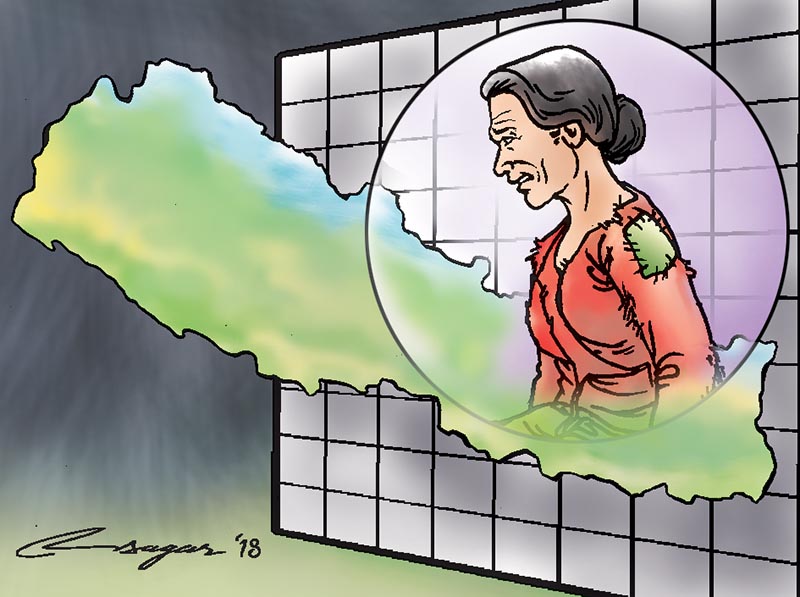Poverty dimensions: The poor need attention
People of rural areas are vulnerable to natural disasters, harvest failures and unemployment. Due to weak institutions, facilities and support systems to address health and education risks are not adequate
In Nepal, poverty is viewed as a shortfall in consumption or income of an individual or a household. Apart from this, there are various dimensions related to poverty such as geopolitical tensions (armed insurgencies), socio-cultural issues (gender discrimination and violence, child labour) and the developmental practices of the past. The classic case which is still prevalent today is of wealth and power concentrated in the hands of the few rich.
Nepal still is among the least integrated nations in the world economy. Globalisation seems to have globalised costs and risks and centralised profits and privileges. In this globalisation phase, the majority of Nepali people have been experiencing a decline in their incomes as the economic growth is limited, or concentrated to a small urban populated area. Further, it is contributing to increased income inequality.
People are still deprived of basic public commodities such as water, health services and education. The growing expenditure on military hardware is exceeding spending on social security.
Nepal is a diverse country – geographically, socially and culturally. The mountain, hill and Tarai regions manifest an immense diversity of human settlement patterns, land distribution, productive resources, level of economic development and infrastructure development.
Around 25 per cent of the population is below the poverty line as per the nationally defined poverty line. Nepal was ranked 144th in the Human Development Index (HDI) with a score of 0.558 among 188 countries, according to Human Development Report 2016, published by the United Nations. People of rural areas constitute the majority of the poor. They are vulnerable to natural disasters, harvest failures and unemployment. Due to weak institutions, facilities and support systems to address health and education risks are not adequate. Thus, the poor people are excluded from building their capacities and foundations for enhanced earnings. Women in large numbers still lack preventive measures against vulnerability to chronic diseases such as anaemia due to poor nutrition.
About 35 per cent of adult population is still illiterate.
Every year, reports suggest curable diseases such as malaria, tuberculosis and respiratory diseases claim lives of many people.
It is said that around one fourth of the Nepali people live with untold suffering, exploitation and deprivation. Several studies suggest the richest 10 per cent Nepalis earn nearly nine times more than the poorest 10 per cent. Similarly, the richest 20 per cent share or consume about five times the share of the poorest 20 per cent (Asian Development Bank, 2013-2017). Country-wise data of South Asia presents a pretty bleak picture for Nepal.
The internal labour force is expanding by the year, but the government’s unwillingness to develop market-oriented infrastructure has slowed down the rate of output growth. In recent years, the migration of youth to other countries either for education or employment has become a routine phenomenon. It adds an additional shock to the rural economy, which is already deteriorating.
Previously, most of the poorest of the poor belonged to the Dalit and ethnic communities. They were historically excluded from policy influencing and decision making opportunities.
But the reservation system in government services and political parties has to some extent changed the scenario and more changes are likely to be seen in coming years.
Although poverty eradications is easier said than done, proper mobilisation of resources like knowledge and wealth by the responsible authorities can play a crucial role. Nepal had adopted “Poverty Reduction Strategic Paper (PRSP)” pushed through by the World Bank and International Monetary Fund as its national programme for poverty reduction.
In the middle and late 1980s, Structural Adjustment Programmes (SAPs) and Enhanced SAPs were adopted as the forerunners of PRSP. As such, government priorities were diverted towards investing in social safety measures.
The major dimensions of the human development paradigm-equity, empowerment and sustainability can be obtained only by addressing and alleviating the root cause of poverty and deprivation.
The actions of international and national non-governmental organisations have also been questioned quite often. It can be said that all newcomers in the name of poverty alleviation are just old wine in a new bottle.
The poverty alleviation programmes are conducted without the participation of those poor people for whom these programmes are run. The majority of such programmes are donor-induced. So, these programmes seem to be working to achieve the vested interest of donor agencies rather than what actually the poor people want. By excluding participation of the majority of the vital stakeholders including the poor themselves, the poverty elimination strategy is always in danger of missing the target.
With the frequent changes in government, the policies also change. So, the direction and priorities of the programmes also get diverted. Due to this, many programmes never take off, or those programmes that were started have in general remained only half-completed.






